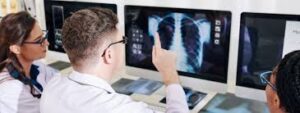Table of Contents
- Introduction
- What are Next-Gen Virtual Consultations?
- The Role of Tele-Imaging in Radiology
- Benefits of Next-Gen Virtual Consultations
- 4.1 Improved Accessibility
- 4.2 Enhanced Collaboration
- 4.3 Cost-Effectiveness
- How Next-Gen Virtual Consultations Improve Radiology Diagnoses with Tele-Imaging
- Challenges and Considerations
- The Future of Next-Gen Virtual Consultations
- Conclusion
Introduction

In an era where technology is reshaping every facet of our lives, Next-Gen Virtual Consultations are revolutionizing the healthcare industry. These advanced digital consultations, paired with innovative Tele-Imaging Services for Radiology, are not only improving the way we approach medical diagnostics but also significantly enhancing patient care. This blog will delve into how these consultations are redefining radiology diagnoses, highlighting the profound impact they have on the medical field.
What are Next-Gen Virtual Consultations?

Next-Gen Virtual Consultations refer to advanced digital consultations that utilize high-quality audio-visual technology, allowing patients and healthcare providers to connect seamlessly from anywhere. This innovative approach enables specialists to evaluate imaging studies, discuss treatment options, and deliver timely diagnoses without the constraints of geographical barriers.
These consultations are integral to the growth of Tele-Imaging Services for Radiology, streamlining the process of obtaining medical imaging and expert opinions. With the convenience of virtual interactions, healthcare providers can optimize patient outcomes while ensuring accessibility and efficiency in care delivery.
The Role of Tele-Imaging in Radiology
Tele-Imaging is the backbone of modern radiology, enabling the transmission of medical images over secure networks for remote diagnosis and consultation. This technology allows radiologists to review images from various locations, facilitating quicker decision-making and collaboration among specialists.
As a critical component of Next-Gen Virtual Consultations, Tele-Imaging services significantly enhance the quality and speed of radiological evaluations. By merging advanced imaging technologies with virtual consultations, healthcare providers can offer unparalleled service to their patients.
Benefits of Next-Gen Virtual Consultations

4.1 Improved Accessibility
One of the most significant advantages of Next-Gen Virtual Consultations is the improved accessibility to healthcare services. Patients in remote or underserved areas can now connect with specialists without the need for extensive travel. This is particularly vital for individuals requiring urgent or specialized radiological assessments, as timely access to care can lead to better health outcomes.
4.2 Enhanced Collaboration
Next-Gen Virtual Consultations foster collaboration among healthcare providers. Radiologists can easily collaborate with other specialists, allowing for a comprehensive approach to patient care. This multidisciplinary cooperation enhances the accuracy of diagnoses and treatment plans, ultimately improving the quality of care delivered to patients.
4.3 Cost-Effectiveness
By eliminating the need for in-person consultations, Next-Gen Virtual Consultations reduce healthcare costs for both patients and providers. Virtual appointments can save patients time and money on travel and associated expenses. For healthcare providers, reduced overhead costs can lead to more competitive pricing and improved access to diagnostic services.
How Next-Gen Virtual Consultations Improve Radiology Diagnoses with Tele-Imaging

The integration of Next-Gen Virtual Consultations with Tele-Imaging significantly improves radiology diagnoses in several key ways:
- Timely Diagnoses: Virtual consultations expedite the review of imaging studies, allowing radiologists to provide quicker diagnoses. This is crucial for conditions where time is of the essence, such as strokes or fractures.
- Comprehensive Evaluation: Radiologists can access a wealth of information through Tele-Imaging, including previous studies and patient histories. This comprehensive view enables more accurate diagnoses and tailored treatment plans.
- Real-time Collaboration: With Next-Gen Virtual Consultations, specialists can discuss findings in real time, ensuring that all healthcare providers involved in a patient’s care are on the same page. This leads to more cohesive treatment strategies and better patient outcomes.
- Remote Monitoring: Patients can be monitored remotely through virtual consultations, enabling ongoing assessments of their conditions. This continuous care approach helps in promptly addressing any emerging issues, further enhancing diagnostic accuracy.
- Patient Engagement: Next-Gen Virtual Consultations empower patients to take an active role in their healthcare. By participating in discussions about their imaging studies and treatment options, patients are more informed and engaged in their care.
Challenges and Considerations
While Next-Gen Virtual Consultations and Tele-Imaging offer numerous benefits, some challenges must be addressed:
- Technical Barriers: Not all patients may have access to the necessary technology for virtual consultations, which can hinder their ability to receive timely care.
- Data Security: Protecting patient information during virtual consultations is paramount. Healthcare providers must implement robust cybersecurity measures to safeguard sensitive data.
- Regulatory Compliance: Providers must navigate various regulations concerning telemedicine and data privacy, which can vary by region and specialty.
The Future of Next-Gen Virtual Consultations
The future of healthcare is being redefined by Next-Gen Virtual Consultations, bridging the gap between cutting-edge technology and patient care. With rapid advancements, these consultations are set to revolutionize the way healthcare professionals diagnose and treat conditions, particularly in radiology.
Imagine a world where augmented reality (AR) and virtual reality (VR) transform diagnostics into immersive, real-time experiences. Radiologists and clinicians could virtually navigate through imaging studies, gaining unprecedented clarity and context for precise diagnoses. These innovations will elevate patient-doctor interactions, creating a more intuitive and comprehensive consultation process.
As telehealth continues its meteoric rise, healthcare institutions worldwide are adopting tele-imaging and virtual consultation models. This trend is driving intense competition and fueling innovation, paving the way for more personalized, accessible, and efficient healthcare solutions. Patients will no longer be bound by geographical limitations; expert opinions will be just a click away, no matter where they live.
The integration of artificial intelligence (AI) is another game-changer in tele-imaging. By analyzing vast amounts of data, AI can identify anomalies with unmatched precision, providing radiologists with actionable insights. These data-driven approaches not only enhance the accuracy of diagnoses but also reduce turnaround times, offering faster and more reliable care to patients.
Conclusion

Contact For Tele Reporting Services
Next-Gen Virtual Consultations represent a significant leap forward in how we approach radiology and patient care. By leveraging advanced Tele-Imaging services, healthcare providers can improve radiology diagnoses, ensuring timely, accurate, and comprehensive care for patients. As technology continues to evolve, the integration of virtual consultations and tele-imaging will undoubtedly enhance the future of healthcare, making it more accessible, efficient, and patient-centered.
In conclusion, the evolution of virtual consultations marks a transformative shift in the healthcare landscape, particularly in the field of radiology. By enhancing accessibility, fostering collaboration among healthcare professionals, and streamlining the diagnostic process, these innovative approaches offer numerous benefits for both patients and providers. The integration of advanced imaging technologies facilitates timely and accurate diagnoses, ultimately leading to improved patient outcomes. As healthcare continues to embrace digital solutions, the potential for enhanced care delivery and patient engagement grows significantly. Overcoming challenges related to technology access, data security, and regulatory compliance will be crucial in maximizing the effectiveness of virtual consultations.

